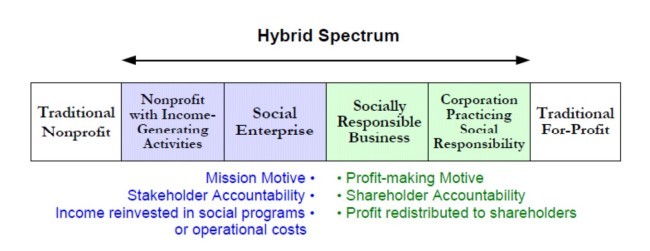
دانلود رایگان مقاله رهبری دوسوتوان، جهت گیری کارآفرینانه اجتماعی و عملکرد عملیاتی

چکیده
در عصر دانش، اشکال جدیدی از سازماندهی و مدیریت شرکت ها برای انطباق با وضعیت های جدید پدیدار می شوند. یکی از این شکل های جدید مدیریت سازمانی، رهبری دوسوتوان است. رهبری دوسوتوان ترکیبی از رفتارهای رهبر مانند ارتقاء خلاقیت و رفتارهای بستن رهبر مانند انجام اهداف و پایبندی به هنجارها می باشد. بنابراین، هدف نشان دادن این است که یک جهت گیری اجتماعی با اقدامات عملکرد عملیاتی, هدفی غیر از سودآوری ندارد. هدف از این مطالعه, بررسی چگونگی ارتباط رهبری دوسوتوان با جهت گیری کارآفرینانه اجتماعی و اینکه چگونه این امر به نوبه خود بر عملکرد عملیاتی تأثیر می گذارد, می باشد. این کار از طریق بررسی دقیق نوشته ها انجام می شود.
1. مقدمه
کارآفرینی در رشد تجارت و همچنین گسترش سریع بخش اجتماعی سهم زیادی داشته است ]1،2]. این مقوله به طور گسترده ای به عنوان کشف فرصت ها تعریف شده است - شکل، اثرات و عوامل تسهیل کننده که به کشف و اکتشاف فرصتهای شغلی کمک می کنند ]3،4]. به موازات آن، Shane و Venkataraman ]4] موضوعاتی راجع به خلق کالاها و خدمات از طریق این فرصت ها، ویژگی های کارآفرینانی که آنها را کشف می کنند و شیوه های عملی برای بهره برداری از فرصت های شغلی را مورد کاوش قرار داده اند.
کارآفرینی, منبع تحول اقتصادی است زیرا اشتغال ایجاد می کند، رشد را پیش می برد و نوآوری را ارتقا می بخشد. به همین ترتیب، کارآفرینی با اتحاد شهروندان، غنی سازی فرهنگ و در نهایت تبدیل شدن به بخشی از جریان های اجتماعی و اقتصادی، انسجام اجتماعی را تقویت می کند.
اصطلاح کارآفرینی بارها و بارها برای حل مشکلات اجتماعی به کار رفته است ]8]. Schumpeter ]9] اظهار داشت که کارآفرینی, فرایندی اساسی است که از طریق آن اقتصاد به طور کلی پیشرفت کرده است. رشته مطالعات تجاری شامل رشته ای است که با عنوان کارآفرینی اجتماعی شناخته می شود و محور این پژوهش می باشد.
Gorgievski و Stephan, کارآفرینی اجتماعی را به عنوان محرک رفاه اقتصادی و اجتماعی و همچنین بهره وری توصیف کردند و نتیجه گیری کردند که کارآفرینی می تواند از طریق اشتغال زایی، پایداری محیط زیست، نوآوری و خوشبختی کارکنان, ارزش ایجاد کند. آنها همچنین استدلال كردند كه مطالعه كارآفرینان منفرد می تواند نوشته های روانشناسی را از نظر بررسی نگرش به عدم قطعیت، انعطاف پذیری، اضطراب و مسئولیت شغلی غنی سازد. تمایل به مطالعه کارآفرینی اجتماعی امری نوظهور است، بنابراین اطلاعات ما در مورد چگونگی مقابله با مشکلات و تصمیمات در این زمینه مختصر است .
در یک چارچوب تجاری که تأثیر شرکت بر جامعه را در نظر می گیرد، شرکت ها باید به عملکرد رقابتی نسبی دست یابند. برای دستیابی به یک مزیت رقابتی, سازمانها باید از سطح نسبتاً بالایی از پیشروی و نوآوری برخوردار باشند. تأثیرات عوامل احتمالی پی فعالی و گرایش به ریسک پذیری مورد مطالعه قرار گرفته است تا آموخته شود که چگونه شرکت ها می توانند نوآوری کنند. این جریان از تحقیقات نتایج مثبتی به همراه داشته است. نوآوری یک عنصر اصلی در جهت گیری کارآفرینانه است، همانند پیش فعال بودن و ریسک پذیری.
با این حال، کارآفرینی اجتماعی به عامل دیگری نیاز دارد که منعکس کننده ویژگیهای خاص اینگونه شرکتها است. این عامل, گرایش کارآفرینی اجتماعی است. جوهره کارآفرینی اجتماعی, جهت گیری کارآفرینانه اجتماعی است. جهت گیری کارآفرینانه اجتماعی به ترکیبی از جهت گیری کارآفرینانه و متقابل اشاره دارد . تقابل مستلزم به دست آوردن آنچه که جامعه دریافت کرده است و بازگرداندن آن در قالب شیوه های پایدار می باشد که به نفع کل جامعه است. نوآوری یک عنصر مشترک در مفاهیم جهت گیری کارآفرینانه، جهت گیری کارآفرینانه اجتماعی و عملکرد عملیاتی است. بنابراین، جهت گیری مدیریتی که منجر به تقویت نوآوری شود، ضروری است.
سبک رهبری که به بهترین وجه اکتشاف و بهره برداری و به تبع آن نوآوری را ارتقا می بخشد، رهبری دوسوتوان است ]19]. رهبران دوسوتوان از رفتارهای رهبر برای تشویق کارمندان برای دنبال نمودن پیش فعال ایده ها و راه حل های جدید استفاده می کنند و سپس به رفتارهای بسته شدن رهبر روی می آورند تا کارگران را به پیاده سازی این این ایده ها و راه حل ها ترغیب کنند. بنابراین، رهبری دوسوتوان, ظرفیت ارتقاء فعالیت، نوآوری و ریسک پذیری توسط کارکنان را دارد.
تعامل بین رفتارهای باز و بستن موجب پیش بینی عملکرد نوآورانه در کارکنان می شود. بنابراین تعامل بیشتر بین دو رفتار به معنای سطوح بالاتر نوآوری است . رهبری دوسوتوان بر عملکرد نوآورانه کارکنان و خلاقیت تأثیر می گذارد.
هدف از این مطالعه، ارائه بینشی در مورد مفهوم رهبری دوسوتوان و سپس سنجش چگونگی پیوند رهبری دوسوتوان با جهت گیری کارآفرینانه اجتماعی است. بنابراین هدف اصلی, سنجش میزان تأثیر گرایش کارآفرینانه اجتماعی بر عملکرد عملیاتی شرکتها است. مروری بر نوشته های مطالعات در وبسایت Science - شاخص علوم اجتماعی (WoS-SSCI) ارائه شده است. تمرکز بر روی تأثیرگذارترین نویسندگان و مقالات در این زمینه می باشد. در نتیجه، تلاش شده است تا شکاف موجود در نوشته ها مربوط به رابطه بین رهبری دوسوتوان، جهت گیری کارآفرینانه اجتماعی و عملکرد عملیاتی پر شود.
Abstract
In the knowledge era, new forms of organizing and managing firms emerge to adapt to new situations. One such new form of organizational management is ambidextrous leadership. Ambidextrous leadership combines opening leader behaviors, such as promoting creativity, and closing leader behaviors, such as accomplishing objectives and adhering to norms. Thus, the aim is to demonstrate that a social orientation is not at odds with measures of operational performance other than profitability. The purpose of this study is to examine how ambidextrous leadership is linked to social entrepreneurial orientation and how this in turn affects operational performance. This is done through a rigorous review of the literature.
1. Introduction
Entrepreneurship has driven much of the growth of the business sector as well as the rapid expansion of the social sector [1,2]. It is broadly defined as the discovery of opportunities—the form, effects, and facilitators that aid the discovery and exploration of business opportunities [3,4]. In parallel, Shane and Venkataraman [4] have explored issues regarding the creation of goods and services through these opportunities, the characteristics of the entrepreneurs who discover them, and the modes of action used to exploit business opportunities.
Entrepreneurship is a source of economic transformation because it creates employment, drives growth, and promotes innovation [5]. Similarly, entrepreneurship fosters social integration by uniting citizens, enriching culture, and ultimately becoming part of social and economic flows [6,7].
The term entrepreneurship has repeatedly been applied to solve social problems [8]. Schumpeter [9] stated that entrepreneurship was a crucial process through which the economy as a whole advanced. The field of business studies includes a discipline known as social entrepreneurship, which is the focus of this study.
Gorgievski and Stephan [10] described social entrepreneurship as a driver of economic and social well-being as well as productivity [10], concluding that entrepreneurship can generate value through job creation, environmental sustainability, innovation, and staff happiness [11]. They also argued that the study of individual entrepreneurs could enrich the psychology literature in terms of exploring attitudes toward uncertainty, flexibility, anxiety, and job responsibility. The tendency to study social entrepreneurship is recent, so we know little about how problems and decisions are tackled in this context [12,13].
Within a business framework that considers corporate impact on society, companies must achieve competitive comparative performance [14]. Organizations must have comparatively high levels of proactiveness and innovativeness [15] to obtain a competitive advantage. The effects of the contingent factors of proactiveness and risk-taking orientation have been studied to learn how companies can innovate. This stream of research has yielded positive results [16]. Innovativeness is a central element in entrepreneurial orientation, as is proactiveness and risk-taking.
However, social entrepreneurship requires another factor, which reflects the specific characteristics of such companies. This factor is social entrepreneurial orientation. The essence of social entrepreneurship is social entrepreneurial orientation [17]. Social entrepreneurial orientation refers to the combination of entrepreneurial orientation and reciprocity [18]. Reciprocity entails taking what society has received and returning it in the form of sustainable practices that benefit society as a whole. Innovation is a common element to the concepts of entrepreneurial orientation, social entrepreneurial orientation, and operational performance. Therefore, a managerial orientation conducive to fostering innovation is necessary.
The leadership style that best promotes exploration and exploitation and, consequently, innovation is ambidextrous leadership [19]. Ambidextrous leaders employ opening leader behaviors to encourage employees to proactively seek novel ideas and solutions and then shift to closing leader behaviors to encourage workers to implement these ideas and solutions. Therefore, ambidextrous leadership has the capacity to promote proactiveness, innovativeness, and risk-taking by employees [20].
The interaction between opening and closing behaviors predicts innovative performance in employees. Therefore, greater interaction between the two behaviors means higher levels of innovativeness [21,22]. Ambidextrous leadership influences employees’ innovative performance [23] and creativity [24].
The purpose of this study is to offer insight into the concept of ambidextrous leadership and then measure how ambidextrous leadership is linked to social entrepreneurial orientation. The main objective is therefore to measure how social entrepreneurial orientation affects firms’ operational performance. A literature review of studies in the Web of Science-Social Sciences Citation Index (WoS-SSCI) database is presented. The focus is on the most influential authors and articles in this field. Consequently, an attempt is made to fill the gap in the literature on the relationship between ambidextrous leadership, social entrepreneurial orientation, and operational performance.
چکیده
1. مقدمه
2. چارچوب نظری
2.1 کارآفرینی اجتماعی
2.2. جهت گیری کارآفرینانه
2.2.1 جهت گیری کارآفرینانه اجتماعی
2.2.2 جهت گیری کارآفرینانه در رابطه با مزیت رقابتی پایدار
2.3 رهبری
2.3.1 سبک ها و مدل های رهبری
2.3.2 نوآوری در رهبری
نوآوری و خلاقیت
رهبری تحول گرا و معاملاتی در رابطه با نوآوری
2.3.3 رهبری دوسوتوان
3. رویکردهای اصلی نظری و توجیه تحقیق
3.1 متغیرها
4. نتیجه گیری ها
4.1 مشارکت
4.2. محدودیت های مطالعه
4.3 تحقیقات آینده
منابع
Abstract
1. Introduction
2. Theoretical Framework
2.1. Social Entrepreneurship
2.2. Entrepreneurial Orientation
2.2.1 Social Entrepreneurial Orientation
2.2.2. Entrepreneurial Orientation in Relation to Sustainable Competitive Advantage
2.3. Leadership
2.3.1. Leadership Styles and Models
2.3.2. Innovation in Leadership
Innovation and Creativity
Transformational and Transactional Leadership in Relation to Innovation
2.3.3. Ambidextrous Leadership
3. Main Theoretical Approaches and Justification of the Research
3.1. Variables
4. Conclusions
4.1. Contribution
4.2. Study Limitations
4.3. Future Research
References
